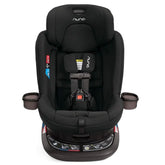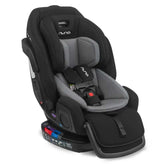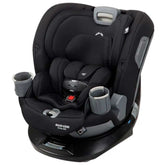Age-Appropriate Car Seats: A Quick Guide for Every Stage

At ANB Baby, we know that ensuring the safety of our little ones is a top priority for parents, especially when it comes to traveling in vehicles. One of the most important ways to do this is by choosing the right car seat for each developmental stage. In this comprehensive guide, we’re breaking down car seat recommendations based on a child’s age and developmental stage, helping you select the most appropriate car seat for your growing baby.

Infant Car Seats (0-12 months): Providing Maximum Safety for Your Newborn
During the first year of life, infants are particularly vulnerable, requiring a specialized car seat designed to provide maximum protection for their delicate bodies. The American Academy of Pediatrics (AAP) strongly recommends the use of rear-facing infant car seats for newborns at least up to the age of 12 months. This positioning is crucial as it offers optimal protection to the infant's head, neck, and spine—the most vulnerable areas in the event of a crash. The rear-facing orientation absorbs the impact and distributes the force across the car seat, minimizing the risk of injury. To ensure the highest level of safety, infants should remain in a rear-facing car seat until they reach the maximum weight or height allowed by the car seat manufacturer.
Installation and Placement Guidelines for Infant Car Seats
Equally important as choosing the right type of car seat is its correct installation. The National Highway Traffic Safety Administration (NHTSA) emphasizes that infants should always ride in the back seat, as it is the safest location in the event of a crash. Additionally, securing the car seat according to both the car seat and vehicle manufacturer's guidelines is crucial for its effectiveness. Parents must take the time to carefully read and understand the installation instructions provided with the car seat. This includes using the correct type of seat belt or LATCH system and ensuring a snug fit. A properly installed infant car seat significantly reduces the risk of injury during an accident.
Adjustable Features for Comfort and Safety on Infant Car Seats
Infant car seats come equipped with adjustable features to accommodate the unique needs of newborns. These features include padded inserts for additional support and harness systems designed to secure even the tiniest passengers comfortably. It's essential to follow the manufacturer's guidelines for using these features based on the infant's size and developmental stage. Additionally, parents should regularly check the tightness of the harness to ensure a secure fit. The straps should be snug enough to pass the "pinch test," where there should be no excess slack when pinching the strap at the shoulder level.
Safely Transitioning to the Next Stage from an Infant Car Seat
Most infant car seats have weight limits ranging from 22 to 35 pounds. That said, many babies outgrow these seats in height before reaching the weight limit, particularly for those with 30+ pound limits. The general guideline is that a child is considered too tall for the infant seat when their head is within 1 inch of the top of the seat. Familiarizing yourself with your specific car seat's height and weight requirements is essential to ensure your child is riding safely.
Based on AAP recommendations, it’s time to transition your baby to a rear-facing convertible car seat once they meet the minimum height or weight requirement for their infant seat. Avoid using the seat if the child exceeds either the weight or height limit, as safety is compromised in both scenarios. Once your child hits one of these limits, it's a clear indication that they have outgrown the infant seat.

Convertible Car Seats (0-3 years): Adapting to Your Child's Growth from Birth
Versatile and designed for long-term use, convertible car seats cater to infants and toddlers alike, accommodating both rear-facing and forward-facing positions. As such, convertible car seats offer a seamless transition from the infant stage, ensuring optimal protection for their delicate bodies. Parents can start using the convertible car seat in the rear-facing position for newborns and then adapt it to the forward-facing position as the child grows.
Extended Rear-Facing Time for Convertible Car Seats
The AAP advises parents to extend the rear-facing position for as long as possible, preferably until the child reaches the maximum height or weight limit set by the car seat manufacturer. This prolonged rear-facing option offered by a convertible car seat enhances protection for the head, neck, and spine, aligning with the unique vulnerabilities of toddlers during this stage of development.
Convertible car seats also come equipped with adjustable features to accommodate the changing needs of growing children. Padded inserts and customizable harness systems ensure a snug fit, providing both safety and comfort for infants and toddlers. Parents will need to regularly check and adjust these features as their child progresses through different developmental stages.
Safely Transitioning to Forward-Facing in a Convertible Car Seat
Around the age of two, when most children outgrow the rear-facing limits, the convertible car seat seamlessly transitions to the forward-facing position. During this transition, the NHTSA emphasizes the correct placement of harness straps at or above the child's shoulders, enhancing protection during frontal collisions—the most common type of accident.
Installation and Usage Guidelines for Convertible Car Seats
Proper installation of the convertible car seat is critical for its effectiveness. Parents should diligently follow both the car seat and vehicle manufacturer's guidelines to ensure a secure fit. Placing the car seat in the back seat, as recommended by the NHTSA, further enhances safety.

Booster Seats (4-12 years): Elevating Safety as Your Child Grows
As your child progresses through the early years of childhood, transitioning from a forward-facing car seat to a booster seat becomes a crucial step in maintaining their safety on the road. Booster seats serve as an intermediary safety measure, ensuring that the vehicle's seat belt fits properly across the chest and lap of a growing child, providing optimal protection in the event of an accident.
Height and Age Considerations for Booster Seats
Typically, around the age of four, when a child outgrows their forward-facing car seat, it's time to introduce a booster seat. Both the AAP and the NHTSA recommend using a booster seat until the child is big enough to use the vehicle seat belt alone safely. This readiness is usually determined by a height of 4 feet 9 inches—the recommended height for transitioning to a seat belt without a booster. Ensuring the child can sit comfortably in the booster seat, with the seat belt properly positioned across their chest and lap, is essential for their safety.
Types of Booster Seats
Booster seats come in two main types: high-back boosters and backless boosters. High-back boosters provide additional head and neck support and are suitable for vehicles without headrests. On the other hand, backless boosters are more portable and can be a practical choice for older children who have adequate head and neck control. It's essential to choose the type of booster seat that best suits your child's needs and the specifications of your vehicle. Always follow the manufacturer's guidelines for installation and usage to ensure optimal safety.
Proper Seat Belt Fit in a Booster Seat
The primary purpose of a booster seat is to elevate the child, allowing the vehicle's seat belt to fit properly. The lap belt should sit low and snug across the child's hips, and the shoulder belt should cross their chest without touching the neck. If the seat belt doesn't fit correctly without a booster, the child remains at risk for injuries during a collision. Regularly checking the fit of the seat belt and the stability of the booster seat is crucial as your child continues to grow. Ensuring a proper fit enhances the effectiveness of the seat belt in protecting during a crash.
The Safest Seating Position for a Booster Seat
Booster seats should always be installed in the back seat of the vehicle, following the NHTSA's recommendation that children aged 13 and younger should ride in the back seat for maximum safety. This positioning minimizes the impact of airbags and provides an extra layer of protection for children in the event of a frontal collision.

The Takeaway on Age-Appropriate Car Seats
Choosing the right car seat for your child's age and developmental stage is a critical aspect of ensuring their safety during car journeys. We recommend parents regularly check the updated guidelines provided by the American Academy of Pediatrics and the National Highway Traffic Safety Administration to assist them in navigating the complex world of car seat options.
Remember, each child is unique, and it's essential to follow the specific recommendations and guidelines provided by both the car seat and vehicle manufacturers. Regularly check for recalls and updates to ensure your child's car seat is meeting the latest safety standards. By staying informed and following these age-appropriate car seat recommendations, parents can provide their children with the safest possible travel experience. As our little ones grow, so do their needs for protection, making it crucial to adapt and choose the right car seat for each stage of their development.










